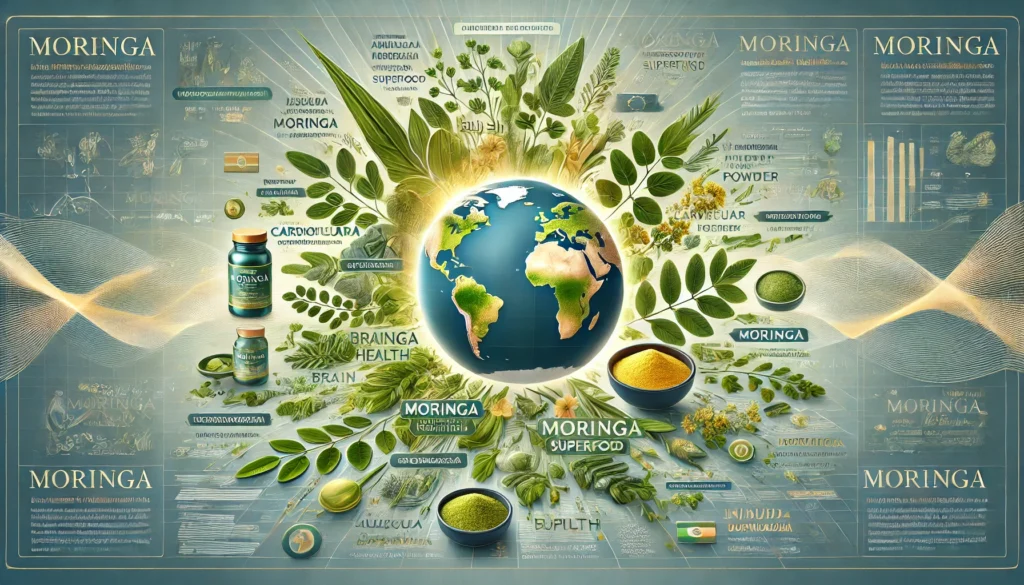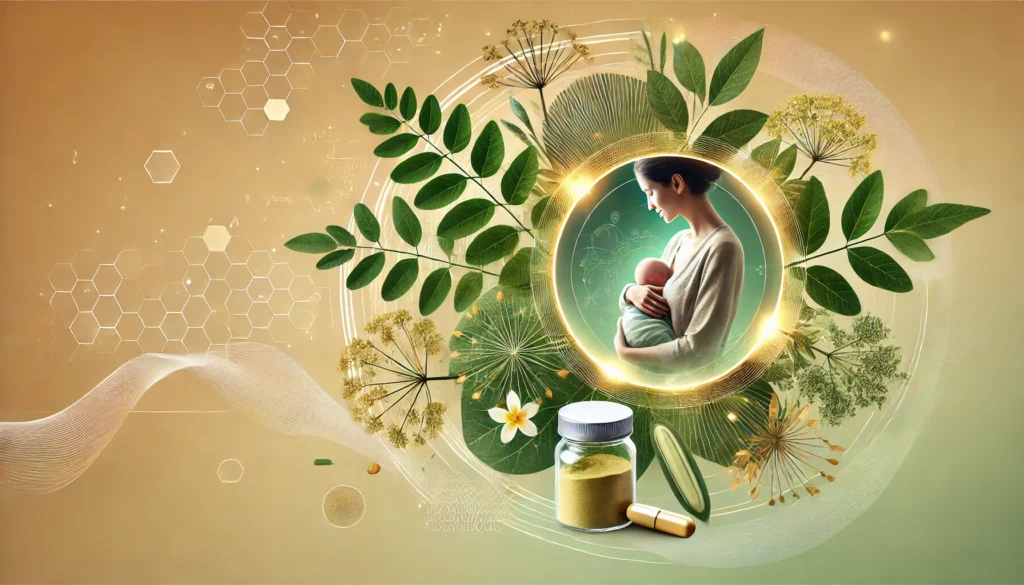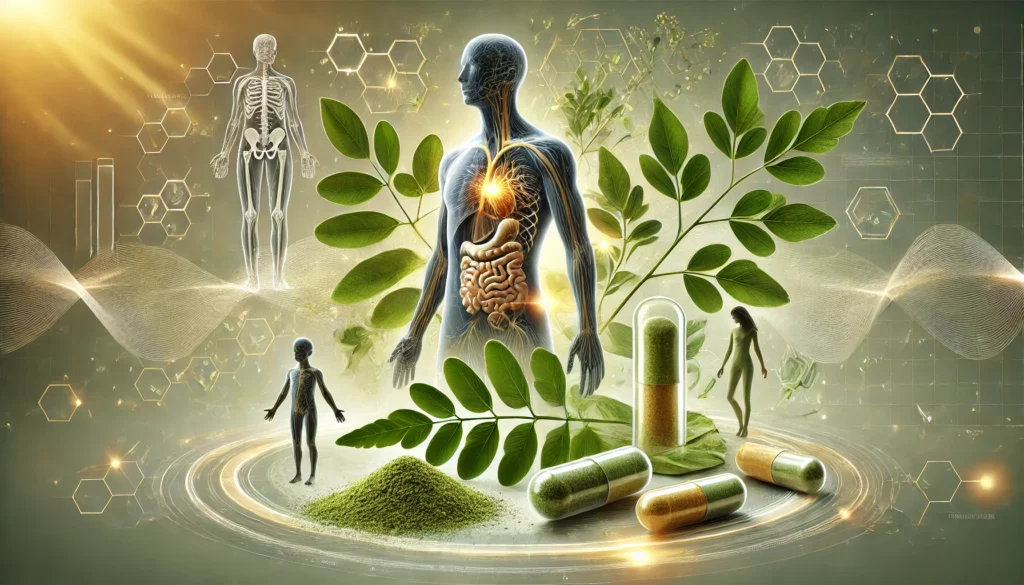The “Miracle Tree,” Moringa Oleifera, is renowned across the world for its vast array of therapeutic benefits and unmatched nutritional worth. This herb, which is valued in conventional medicine and accepted by contemporary science, is essential to the pursuit of health and well-being. Originating in the Himalayan foothills and currently grown in tropical places worldwide, Moringa has become ingrained in many civilizations, each of which has discovered and applied its advantages in a different way. Malnutrition, inflammation, and chronic illnesses are just a few of the health issues that Moringa addresses with its nutrient-rich leaves and potent antioxidant-rich seeds. Moringa is a natural health icon.
In-depth exploration of the vitamins, minerals, and bioactive components that make Moringa Oleifera a unique superfood is provided in this article. We go across continents to discover the delicious marvel of the tree, its worldwide effect, and how it combats malnutrition and encourages lactation. Come along as we share the secrets of the Miracle Tree, Moringa Oleifera, and demonstrate how its amazing health benefits may improve our lives.
You May Also Like:
Moringa: Drug and Supplement Interaction Profile
Nutrient-Rich
This plant’s nutrient-rich profile makes it an exceptional dietary supplement, offering a wide range of vitamins, minerals, antioxidants, and proteins. Here’s a detailed look at the nutrients found in Moringa:
Vitamins
- Vitamin A (Beta-Carotene): Moringa leaves are rich in vitamin A, which is vital for maintaining healthy vision, immune function, and skin health. The beta-carotene in Moringa is a powerful antioxidant that helps protect cells from damage.
- Vitamin C: With a content higher than that found in oranges, Vitamin C in Moringa boosts the immune system, helps reduce chronic diseases, and improves skin health by stimulating collagen production.
- Vitamin E: Moringa contains vitamin E, which acts as a potent antioxidant to protect against oxidative stress and inflammation. It also supports healthy skin and eyes.
- Vitamin B1 (Thiamine): Thiamine in Moringa plays an essential role in converting sugars into energy, contributing to metabolism and nerve function.
- Vitamin B2 (Riboflavin): Riboflavin is important for energy production, cellular function, and the metabolism of fats, drugs, and steroids.
- Vitamin B3 (Niacin): Niacin in Moringa aids in digestion, skin health, and the conversion of food into energy.
- Folate (B9): Crucial for DNA synthesis and repair, folate from Moringa supports brain health and fetal development during pregnancy.
Minerals
- Calcium: Moringa leaves contain high levels of calcium, which is essential for maintaining strong bones and teeth, nerve signaling, muscle function, and blood clotting.
- Potassium: With a higher content than bananas, potassium in Moringa helps regulate fluid balance, muscle contractions, and nerve signals.
- Iron: Moringa is a significant source of iron, necessary for the production of hemoglobin and myoglobin, which carry oxygen in the blood and muscles, respectively. It’s especially beneficial for individuals with anemia.
- Magnesium: Involved in over 300 biochemical reactions in the body, magnesium in Moringa supports muscle and nerve function, blood sugar levels, and blood pressure regulation.
- Zinc: Essential for immune function, wound healing, DNA synthesis, and cell division, zinc in Moringa plays a crucial role in overall health.
Proteins and Amino Acids
Moringa leaves are a complete protein source because they contain all nine essential amino acids, which makes them very high in protein for a plant. For vegetarians and vegans who might find it difficult to obtain all of the required amino acids from plant-based diets, this is very helpful. These amino acids are necessary for muscle growth, repair, and maintenance. They also improve general health.
Antioxidants
Apart from vitamins A, C, and E, Moringa contains several other antioxidants such as:
- Quercetin: This antioxidant may help lower blood pressure and has anti-inflammatory effects.
- Chlorogenic Acid: Found in high amounts in Moringa leaves, chlorogenic acid can help moderate blood sugar levels after meals.
- Beta-Sitosterol: This is a plant sterol known to help lower cholesterol levels, improve heart health, and support the immune system.
Fiber
Moringa leaves help with digestion and support a healthy gut microbiota. They are a good source of dietary fiber. By encouraging sensations of fullness, fiber can aid with regularity, help avoid constipation, and even help with weight management.
Moringa is a helpful dietary supplement because of its high nutrient density, particularly in areas where malnutrition is a problem. Its addition to the diet can promote general health and wellbeing and assist in addressing vitamin deficiencies.
Moringa Exists in Different Languages and Different Locations Around the World
The plant Moringa oleifera, which is well-known for its therapeutic and nutritional qualities, goes by several names in many languages and cultures throughout the world. The variety of names reflects the plant’s widespread distribution around the world as well as its cultural importance and adaptability to a range of traditional uses.
Names in Different Languages
- English: Apart from “Moringa,” it is also called the “Drumstick tree” due to the shape of its seed pods, and the “Horseradish tree” because of the taste of its roots.
- Hindi and Urdu: “Sahjan” “Suhanjna” or “Munaga,” reflecting its widespread use in Indian cuisine and traditional medicine.
- Spanish: Known as “Árbol de las perlas” among other names, Moringa is cultivated and used in many parts of Latin America.
- French: Referred to as “Ben ailée” in Francophone countries, emphasizing its beneficial health properties.
- Arabic: “Al-Ban” or “Shagara al Rauwaq,” highlighting its beauty and utility in the Arab world.
- Swahili: In East Africa, it is called “Mlonge,” and its uses range from nutrition to water purification.
- Filipino: Known as “Malunggay” in the Philippines, where it is a staple ingredient in many dishes and celebrated for its health benefits.
- Thai: In Thailand, it’s referred to as “Marum,” integrating into both Thai cuisine and traditional Thai medicine.
Global Distribution and Cultural Significance
South Asia Ayurveda has traditionally used Moringa in India to treat a wide range of illnesses. Its leaves, petals, and pods are utilized in Indian cuisines like “sambhar” and “dal,” making it a staple of the food. In Indian culture, Moringa is highly valued for its nutritional qualities and is known for strengthening the immune system and promoting overall well-being.
South Asia
Ayurveda has traditionally used Moringa in India to treat a wide range of illnesses. Its leaves, petals, and pods are utilized in Indian cuisines like “sambhar” and “dal,” making it a staple of the food. In Indian culture, Moringa is highly valued for its nutritional qualities and is known for strengthening the immune system and promoting overall well-being.
Southeast Asia
A vital tool in the fight against hunger, Moringa is prized in the Philippines and Thailand not only for its high nutritional value but also for its hardiness. It is a staple of the local diet and may be found in a wide variety of meals, including breads and soups.
Africa
Moringa is used as a food source and for medical purposes in several African countries. Moringa leaves are frequently used to soups and stews in nations like Senegal, Kenya, and Nigeria. The plant is also used in traditional medical procedures. In rural areas, its capacity to cleanse water is especially appreciated.
Latin America and the Caribbean
Moringa is grown for its nutritional supplements and as a natural medicine for illnesses in places like Haiti and Mexico. Its quick growth and environmental flexibility make it a desirable choice for reforestation and local agriculture initiatives.
North America and Europe
Despite not being native to these areas, Moringa is becoming more and more well-known as a superfood throughout North America and Europe. Due to its high nutrient profile and several health advantages, it is primarily found in powdered form and is utilized in smoothies, supplements, and health goods.
The flexibility and universal utility of Moringa Oleifera are highlighted by its various nomenclature and global presence. Moringa is revered for its cultural importance as well as its nutritional and therapeutic qualities in a variety of climates and societies. This broad acknowledgement and application of Moringa underscores its potential as a vital tool in tackling global health and nutrition issues.

Nutritional Support for Lactation
Breastfeeding moms can increase lactation and produce more breast milk by using Moringa Oleifera, which is known for having an exceptional nutritional profile. Mothers looking to increase their breast milk production have a safe and efficient option with this natural galactagogue. This article goes into great detail on the benefits of Moringa for nursing moms and how it helps with lactation.
Vitamins, minerals, and amino acids—all necessary for nursing mothers—are abundant in Moringa leaves. As well as minerals including calcium, iron, potassium, magnesium, and zinc, they are highly concentrated in vitamins A, C, E, and B complex. The proper growth and development of the newborn, as well as the mother’s general health, depend on these nutrients.
Protein
Moringa’s high protein concentration promotes tissue growth and repair, which is important for nursing mothers and their babies. Breast milk, which is high in protein and meets the nutritional needs of developing babies, cannot be produced without protein.
Calcium
The calcium level of Moringa is much higher than that of dairy products. In addition to being essential for the growth of healthy bones and teeth in babies, calcium also helps to maintain the bone density of nursing mothers.
Iron
Postpartum anemia, a prevalent ailment among new moms, is aided by the iron found in Moringa. Sufficient iron levels promote proper blood flow and oxygenation, which are essential for meeting the energy needs of nursing.
Vitamins
Moringa’s vitamins A and C affect breast milk quality in addition to bolstering the immune system. The development of the baby’s heart, lungs, kidneys, eyes, bones, respiratory, circulatory, and central nervous systems all depend on vitamin A. Vitamin C helps the baby’s immune system grow and improves the absorption of iron.
Promoting Breast Milk Production
The phytochemicals in Moringa, especially some particular amino acids, may help stimulate the mammary glands to produce more breast milk. Though the precise process is unknown, these substances are thought to function similarly to the body’s natural lactogenic hormones, which control the production of milk.
Scientific Evidence
Numerous research studies have looked into how supplementing with Moringa affects lactation. The “Philippine Journal of Pediatrics” released a noteworthy study that indicated moms who took Moringa leaf powder had a statistically significant increase in their milk volume over those who did not. According to a different study, taking supplements of Moringa as early as the second day may enhance the production of breast milk.
How to Use Moringa for Lactation
There are several ways to include Moringa in a nursing mother’s diet: fresh leaves, powder, pills, and tea. The powder is a flexible supplement that may be used in soups, smoothies, and other recipes. Before beginning any supplement, including Moringa, women should speak with their healthcare practitioners to make sure it is suitable for their particular circumstances.
In general, eating amounts of Moringa is regarded as safe. Because of its strong qualities, nursing moms should take their prescriptions as prescribed by their doctors to prevent any negative effects or drug interactions. To guarantee purity and safety, purchasing Moringa products from reliable vendors is also essential.
If nursing moms want to boost the amount of milk they produce, Moringa Oleifera provides a nutrient-rich, natural solution. In addition to promoting lactation, its high concentration of vital vitamins, minerals, and amino acids also benefits the general health and wellbeing of the mother and child. Growing scientific data supports the lactogenic qualities of Moringa, making it a highly useful supplement for nursing moms globally.

The Moringa Tree is Entirely Edible, from Root to Leaf
The Moringa Oleifera tree, sometimes called the “Miracle Tree,” is well-known for its exceptional nutritional profile and health advantages, but it’s also special since almost every portion of the tree is edible and has different benefits. Moringa is a very adaptable plant with many nutritional and therapeutic uses for its leaves, seeds, pods, flowers, bark, and roots, among other parts of the plant. Here’s a comprehensive look into the uses for every part of the Moringa tree.
Leaves
The most well-known and useful feature of the Moringa tree is its leaves. They are rich in calcium, potassium, protein, and the vitamins A, C, and E. They are also extremely nutrient-dense. Fresh leaves can be added to salads, steamed, boiled, or powdered into a fine powder to add to smoothies, soups, and sauces. A well-liked dietary supplement, Moringa leaf powder is recognized for strengthening the immune system, increasing energy, and assisting with blood sugar regulation.
Pods
“Drumsticks,” or Moringa pods, are a staple in many Asian cuisines, particularly in Indian dishes like curries and sambar. The pods are a good source of potassium, dietary fiber, and vitamin C. After being boiled until tender, the pulp can be removed from the hard outer shell and consumed. When the seeds inside the pods are still young and fragile, they can also be eaten.
Seeds
The tiny, rounded seeds of the Moringa plant have a slightly bitter flavor. Their high oil content is well recognized; it may be extracted and utilized as Ben oil, a cooking oil. This oil is useful for cooking since it is odorless, sweet, and transparent, resembling olive oil in its qualities. Furthermore, because of the seeds’ coagulating qualities, they are utilized to purify water. They can aid in purifying water by eliminating pollutants when crushed and added. Traditional medicine uses Moringa seeds, which are said to have antibacterial qualities, to cure a range of illnesses.
Flowers
The white, tiny, fragile Moringa blossoms have a pleasant scent. They are frequently added to salads and tea, and they can be consumed raw or cooked. The blooms are fried and battered in some cultures. They contain a high potassium and calcium content and have expectorant qualities, which makes them beneficial for treating respiratory conditions like colds.
Bark and Roots
Since they have such strong qualities, the bark and roots of the Moringa tree are used less often than other portions. These should be consumed cautiously and under a healthcare provider’s advice as they contain components that can have powerful effects on the body. Fever, fungal infections, and inflammation can all be treated with the bark in traditional medicine. When used sparingly as a condiment or flavoring, the roots’ flavor is similar to that of horseradish. If ingested improperly, the roots and bark may be hazardous due to the presence of certain alkaloids and other chemicals.
With every part of the tree useful for food, medicine, or other purposes, the Moringa tree truly is a “Miracle Tree.” It is an essential resource in many parts of the world due to its abundant availability as well as its nutritional and therapeutic qualities, especially in areas with limited access to wholesome food and medical care. Though most individuals can safely eat the leaves, pods, and seeds of the plant, the bark and roots of the plant should be used carefully because of their strong nature. Before adding Moringa to your diet, especially in medicinal forms or quantities, it’s crucial that you speak with a healthcare expert, just like you should with any supplement or medicinal plant.
Moringa Fights against Malnutrition
Known as the “Miracle Tree,” Moringa Oleifera is important in the fight against malnutrition, particularly in underdeveloped nations where there is limited access to a wide range of nutrient-dense dietary options. It is a significant tool in the fight against hunger because of its exceptional nutrient density, quick growth rate, and capacity to flourish under challenging environmental conditions. This is a thorough examination of how Moringa prevents malnutrition:
High Nutrient Density
Moringa leaves are exceptionally rich in vitamins, minerals, proteins, and vital amino acids, which are the building blocks of proteins required by the body for growth, repair, and maintenance. Specifically, Moringa leaves contain:
- Vitamins: A significant source of vitamins A, C, and E, which are crucial for immune function, skin health, and protecting the body against oxidative stress.
- Minerals: Rich in calcium and iron, Moringa helps in building strong bones and combating anemia, a common condition in malnourished populations. It also contains potassium, magnesium, and zinc.
- Proteins: Moringa leaves are a rare plant source of all nine essential amino acids, making it a complete protein source. This is particularly important in vegetarian diets where obtaining complete protein can be challenging.
Easy Cultivation and Accessibility
Moringa trees are remarkably resilient and can grow in poor soils, including arid and semi-arid areas, with minimal water. This makes it an ideal crop for regions prone to drought and where agricultural resources are limited. Its rapid growth rate and ease of cultivation mean that communities can quickly establish a sustainable source of nutrition.
Versatility in Consumption
The Moringa tree is a remarkably adaptable resource because every component of it can be used for food and wellness. The majority of the nutritious value of the leaves can be preserved by drying and powdering them, then adding them to teas, soups, and meals. This powder offers a sustained supply of nutrients and is convenient to store and transport. In addition to their edible form, the pods, seeds, and even flowers of the Moringa tree provide significant nutritional value and health advantages.
Supports Infant Health
Malnutrition is particularly devastating in the first 1,000 days of a child’s life, from pregnancy through the first two years. Moringa increases the quantity and quality of breast milk in nursing mothers, which is crucial for infant health and development. The high iron content in Moringa also helps prevent anemia in pregnant women, contributing to healthier outcomes for both mother and child.
Economic Benefits
Growing Moringa can benefit communities economically in addition to its health benefits. It may be produced alongside other crops in agroforestry systems, improving soil health and biodiversity, and it requires relatively little investment. Products made from Moringa, including as powders, oils, and leaves, can be sold to provide money for families, which helps to reduce poverty and enhance nutrition.
Educational and Community Initiatives
The goal of a plethora of initiatives and organizations worldwide is to teach local populations the advantages of Moringa as well as how to cultivate and utilize it. The public’s understanding of this “Miracle Tree” and its ability to fight malnutrition must be expanded thanks to these measures. Improving nutritional status and general health is directly impacted by including Moringa into community gardens and school feeding programs.
Moringa oleifera, which can supply substantial amounts of essential nutrients, provides a long-term, economical solution to malnutrition. Because to its adaptability, simplicity in growing, and multitude of applications, Moringa is a remarkable ally in the worldwide battle against malnutrition. Communities can significantly improve public health outcomes and eradicate malnutrition by utilizing the full potential of Moringa, particularly for the most vulnerable groups.

Medicinal Uses Of Moringa Tree
Moringa Oleifera has been used for centuries in various traditional medicine systems around the world, including Ayurveda, Unani, and many African folk medicinal systems. Here’s a detailed exploration of the medicinal uses of Moringa across different parts of the plant:
Antioxidant and Anti-inflammatory Properties
- Rich in Antioxidants: Moringa leaves are packed with antioxidants such as quercetin, chlorogenic acid, beta-carotene, and Vitamin C, which help in preventing oxidative stress and damage to cells. Antioxidants neutralize free radicals in the body, contributing to the prevention of chronic diseases such as heart disease and type 2 diabetes.
- Anti-inflammatory Effects: Chronic inflammation is associated with many chronic diseases, including cardiovascular disease, diabetes, arthritis, and respiratory problems. Moringa contains isothiocyanates, which are known to possess anti-inflammatory properties, helping to reduce inflammation and the associated health risks.
Nutritional Support and Anemia Prevention
- High Nutritional Value: The leaves of the Moringa tree are highly nutritious, providing essential vitamins and minerals, including iron and vitamin A. Iron is crucial for preventing anemia, a condition characterized by a lack of healthy red blood cells to carry adequate oxygen to the body’s tissues, resulting in fatigue and weakness.
- Rich in Amino Acids: Moringa leaves contain all nine essential amino acids necessary for protein synthesis, muscle repair, and energy production, which are vital for overall health and well-being.
Cardiovascular Health
- Cholesterol Reduction: Moringa can help reduce cholesterol levels, similar to the effect of many plant foods. Lower cholesterol levels are associated with a reduced risk of heart disease.
- Blood Pressure Control: The isothiocyanates in Moringa may help to lower blood pressure, contributing to heart health and preventing heart disease.
Diabetes Management
- Blood Sugar Control: Moringa helps lower blood sugar levels, which is vital for managing diabetes. Compounds in the plant may help to process sugar more effectively, improving blood sugar control.
Liver Protection
- Supports Liver Function: Moringa can significantly reduce liver damage and fibrosis and restore liver enzymes to normal levels, indicating its protective effect on the liver. This is attributed to the high concentrations of polyphenols in Moringa leaves and flowers that help to protect the liver against oxidation, toxicity, and damage.
Kidney Health
- Protects Against Kidney Disorders: Moringa has a protective effect against nephrotoxicity, which refers to the toxicity in the kidneys due to exposure to certain substances. It helps in reducing the formation of kidney stones and ensures the kidneys function optimally.
Antimicrobial and Antibacterial Properties
- Fights Infections: Extracts from Moringa leaves, seeds, and roots have been found to possess antimicrobial and antibacterial properties, effective against various pathogens. This makes Moringa a natural remedy for infections and wound healing.
Digestive Health
- Aids Digestion: Moringa is rich in fiber, which helps in maintaining a healthy digestive system. It can combat constipation, bloating, and other digestive problems.
Skin and Hair Health
- Promotes Skin and Hair Health: The oil extracted from Moringa seeds is beneficial for the skin and hair, providing hydration and nutrients. It is rich in vitamins and minerals that support healthy skin and hair, helping to heal skin infections and condition hair.
Hormonal Balance and Menopause Support
- Supports Hormonal Balance: Preliminary studies suggest that Moringa can support hormonal balance and help in alleviating symptoms of menopause by stabilizing hormonal changes and reducing discomfort.
Cancer Prevention
- Anticancer Properties: Some laboratory studies have indicated that Moringa extracts possess properties that might be beneficial in preventing cancer. They can slow the growth of cancer cells by inducing apoptosis or cell death.
Moringa: Facts About this Incredible Plant: Final Verdict
Moringa is a nutrient-rich tree used in traditional medicines around the world for many years. Touted as a “miracle tree,” every part of the Moringa tree is edible and suitable for consumption by humans. There are a myriad of conditions for all types of people that Moringa can help with. It’s known by many names, so if you don’t recognize the word “Moringa,” perhaps you should look it up in another language you’re more familiar with instead. It can be safely consumed by people of various genders and ages.

References:
- “Scientist studies the Moringa plant’s medicinal, nutritional benefits.” Retrieved from: https://www.fic.nih.gov/News/GlobalHealthMatters/january-february-2020/Pages/carrie-waterman-studies-Moringa-plants-medicinal-nutritional-benefits.aspx
- “Moringa oleifera is a Prominent Source of Nutrients with Potential Health Benefits.” Retrieved from: https://www.ncbi.nlm.nih.gov/pmc/articles/PMC8373516/
- “The effect of Moringa oleifera capsule in increasing breastmilk volume in early postpartum patients: A double-blind, randomized controlled trial.” Retrieved from: https://www.ncbi.nlm.nih.gov/pmc/articles/PMC8023461/
Important Note: The information contained in this article is for general informational purposes only, and should not be construed as health or medical advice, nor is it intended to diagnose, prevent, treat, or cure any disease or health condition. Before embarking on any diet, fitness regimen, or program of nutritional supplementation, it is advisable to consult your healthcare professional in order to determine its safety and probable efficacy in terms of your individual state of health.
Regarding Nutritional Supplements Or Other Non-Prescription Health Products: If any nutritional supplements or other non-prescription health products are mentioned in the foregoing article, any claims or statements made about them have not been evaluated by the U.S. Food and Drug Administration, and such nutritional supplements or other health products are not intended to diagnose, treat, cure, or prevent any disease.

